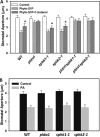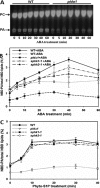Connections between sphingosine kinase and phospholipase D in the abscisic acid signaling pathway in Arabidopsis
- PMID: 22275366
- PMCID: PMC3318714
- DOI: 10.1074/jbc.M111.274274
Connections between sphingosine kinase and phospholipase D in the abscisic acid signaling pathway in Arabidopsis
Abstract
Phosphatidic acid (PA) and phytosphingosine 1-phosphate (phyto-S1P) both are lipid messengers involved in plant response to abscisic acid (ABA). Our previous data indicate that PA binds to sphingosine kinase (SPHK) and increases its phyto-S1P-producing activity. To understand the cellular and physiological functions of the PA-SPHK interaction, we isolated Arabidopsis thaliana SPHK mutants sphk1-1 and sphk2-1 and characterized them, together with phospholipase Dα1 knock-out, pldα1, in plant response to ABA. Compared with wild-type (WT) plants, the SPHK mutants and pldα1 all displayed decreased sensitivity to ABA-promoted stomatal closure. Phyto-S1P promoted stomatal closure in sphk1-1 and sphk2-1, but not in pldα1, whereas PA promoted stomatal closure in sphk1-1, sphk2-1, and pldα1. The ABA activation of PLDα1 in leaves and protoplasts was attenuated in the SPHK mutants, and the ABA activation of SPHK was reduced in pldα1. In response to ABA, the accumulation of long-chain base phosphates was decreased in pldα1, whereas PA production was decreased in SPHK mutants, compared with WT. Collectively, these results indicate that SPHK and PLDα1 act together in ABA response and that SPHK and phyto-S1P act upstream of PLDα1 and PA in mediating the ABA response. PA is involved in the activation of SPHK, and activation of PLDα1 requires SPHK activity. The data suggest that SPHK/phyto-S1P and PLDα1A are co-dependent in amplification of response to ABA, mediating stomatal closure in Arabidopsis.
Figures








Similar articles
-
Crosstalk between Phospholipase D and Sphingosine Kinase in Plant Stress Signaling.Front Plant Sci. 2012 Mar 19;3:51. doi: 10.3389/fpls.2012.00051. eCollection 2012. Front Plant Sci. 2012. PMID: 22639650 Free PMC article.
-
Copper amine oxidase and phospholipase D act independently in abscisic acid (ABA)-induced stomatal closure in Vicia faba and Arabidopsis.J Plant Res. 2014 Jul;127(4):533-44. doi: 10.1007/s10265-014-0633-3. Epub 2014 May 11. J Plant Res. 2014. PMID: 24817219
-
Phospholipase dalpha1 and phosphatidic acid regulate NADPH oxidase activity and production of reactive oxygen species in ABA-mediated stomatal closure in Arabidopsis.Plant Cell. 2009 Aug;21(8):2357-77. doi: 10.1105/tpc.108.062992. Epub 2009 Aug 18. Plant Cell. 2009. PMID: 19690149 Free PMC article.
-
"Dicing and Splicing" Sphingosine Kinase and Relevance to Cancer.Int J Mol Sci. 2017 Sep 2;18(9):1891. doi: 10.3390/ijms18091891. Int J Mol Sci. 2017. PMID: 28869494 Free PMC article. Review.
-
Mammalian sphingosine kinase (SphK) isoenzymes and isoform expression: challenges for SphK as an oncotarget.Oncotarget. 2017 May 30;8(22):36898-36929. doi: 10.18632/oncotarget.16370. Oncotarget. 2017. PMID: 28415564 Free PMC article. Review.
Cited by
-
Phosphoglycerolipids are master players in plant hormone signal transduction.Plant Cell Rep. 2013 Jun;32(6):839-51. doi: 10.1007/s00299-013-1399-0. Epub 2013 Mar 8. Plant Cell Rep. 2013. PMID: 23471417 Review.
-
Genetic and molecular basis of carotenoid metabolism in cereals.Theor Appl Genet. 2023 Mar 20;136(3):63. doi: 10.1007/s00122-023-04336-8. Theor Appl Genet. 2023. PMID: 36939900 Review.
-
Nitric oxide-sphingolipid interplays in plant signalling: a new enigma from the Sphinx?Front Plant Sci. 2013 Sep 12;4:341. doi: 10.3389/fpls.2013.00341. Front Plant Sci. 2013. PMID: 24062754 Free PMC article. Review.
-
Grape exosome-like nanoparticles induce intestinal stem cells and protect mice from DSS-induced colitis.Mol Ther. 2013 Jul;21(7):1345-57. doi: 10.1038/mt.2013.64. Epub 2013 Jun 11. Mol Ther. 2013. PMID: 23752315 Free PMC article.
-
Profiling miRNA expression in photo-thermo-sensitive male genic sterility line (PTGMS) PA64S under high and low temperature.Plant Signal Behav. 2019;14(12):1679015. doi: 10.1080/15592324.2019.1679015. Epub 2019 Oct 14. Plant Signal Behav. 2019. PMID: 31610741 Free PMC article.
References
-
- Wang X., Devaiah S. P., Zhang W., Welti R. (2006) Signaling functions of phosphatidic acid. Prog. Lipid Res. 45, 250–278 - PubMed
-
- Bargmann B. O., Munnik T. (2006) The role of phospholipase D in plant stress responses. Curr. Opin. Plant Biol. 9, 515–522 - PubMed
-
- Li M., Hong Y., Wang X. (2009) Phospholipase D- and phosphatidic acid-mediated signaling in plants. Biochim. Biophys. Acta 1791, 927–935 - PubMed
-
- Hong Y., Zheng S., Wang X. (2008) Dual functions of phospholipase Dα1 in plant response to drought. Molecular Plant 1, 262–269 - PubMed
Publication types
MeSH terms
Substances
Grants and funding
LinkOut - more resources
Full Text Sources
Molecular Biology Databases

